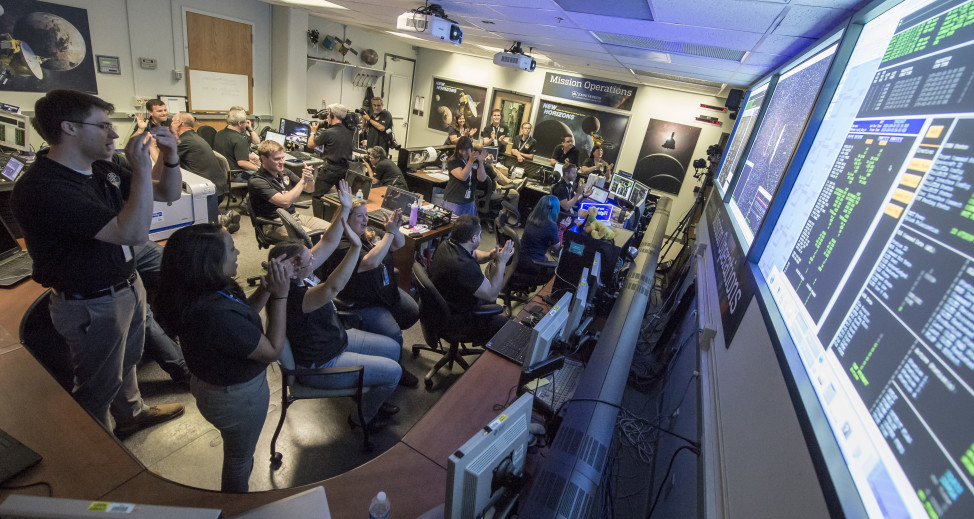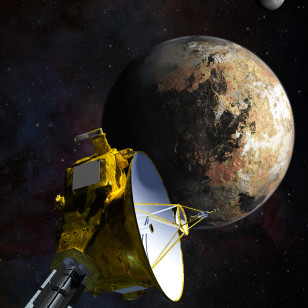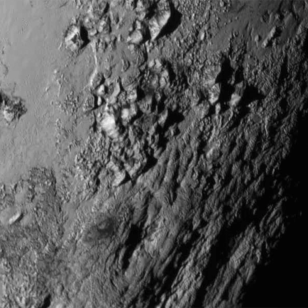
New Horizons Flight Controllers celebrate after they received confirmation from the spacecraft that it had successfully completed the flyby of Pluto, Tuesday, July 14, 2015 in the Mission Operations Center (MOC) of the Johns Hopkins University Applied Physics Laboratory (APL), Laurel, Maryland.
(NASA/Bill Ingalls)
It took a little more than thirteen hours after NASA’s New Horizons mission made its historic close encounter with Pluto and its five known moons, but the piano-sized spacecraft finally phoned home to say that it’s OK and that the fly-by went according to plan.
Anxious members of the New Horizons mission team at the Johns Hopkins University Applied Physics Laboratory (APL) in Laurel, Maryland became jubilant after they started receiving status messages from the spacecraft a little before 0100 UTC on July 15th.
The reason why mission controllers had to wait so long after the fly-by is that New Horizons was instructed not to communicate with Earth until after it flew beyond the Pluto system and had gathered as much data as possible.
After traveling some five billion kilometers into the far reaches of our solar system for nearly a decade, the first spacecraft to be sent to Pluto flew within 12,500 kilometers above the surface of the dwarf planet on July 14th at 1149 UTC.
The New Horizons is the fastest spacecraft that has ever been launched – it’s hurtling through space at more than 52,000 kilometers per hour.
NASA said the spacecraft flew past Pluto and its five known moons while in data-gathering mode and was not in immediate contact with controllers here on Earth.
Mission officials said that the New Horizons has gathered so much data that it will take about 16 months for to send it all back to Earth.
New Horizons was sent into space in January 2006 to explore a region of the solar system beyond the large planets – Jupiter, Saturn, Uranus and Neptune – that’s never been explored before.
This area of space, called the Kuiper Belt, is several billion kilometers wide and contains relatively smaller, icy and rocky objects that are thought to be remnants of the formation of the solar system.
“You can’t understand the solar system, in which we live in, without understanding all its parts,” said Paul Schenk, a co-investigator on the New Horizons science team in an interview with Science World.
Scientists are expecting the spacecraft to send back some amazing images of Pluto and its large moon, Charon as well as “pretty good views” of several of the remaining four smaller moons.

Artist’s concept of the New Horizons spacecraft as it approaches Pluto and its largest moon, Charon. (Johns Hopkins University Applied Physics Laboratory/Southwest Research Institute (JHUAPL/SwRI))
Schenk said that he and his colleagues didn’t actually know that two of the four smaller moons of Pluto even existed until the Hubble Space Telescope and ground based telescopes found them after New Horizons was launched. So, to make sure they would be able to get at least some images of them, the spacecraft’s flight path had to be changed slightly as it made its way to Pluto.
It’s hoped that the images taken by New Horizons will provide scientists with at least an idea of the size and shapes of the moons.
Members of the mission’s team began monitoring Pluto with the spacecraft this past January.
In that time they were able to learn about some of the dwarf planet’s basic characteristics, determine its exact position in space and its orbital dynamics so that they could make sure their targeting was correct as well as look for any of Pluto’s moons that had not yet been discovered.
So far they haven’t been able to spot any new moons, but the search continues.
With the successful fly-by behind them, Schenk said that in October mission members are planning to slightly nudge the spacecraft’s flight path so that they can visit other Kuiper belt objects that might prove to be just as or even more interesting than Pluto and its moons.
Listen to Science World’s interview with Paul Schenk, a co-investigator on the New Horizons science team.
























Comments are closed.